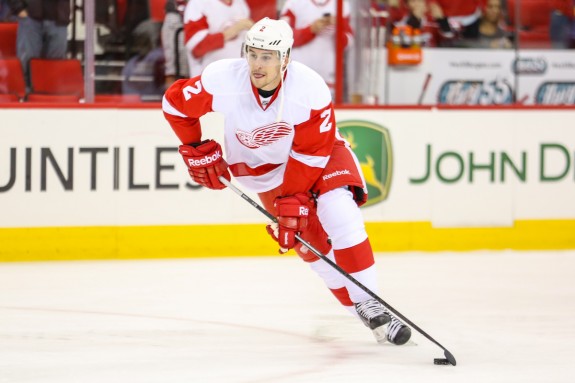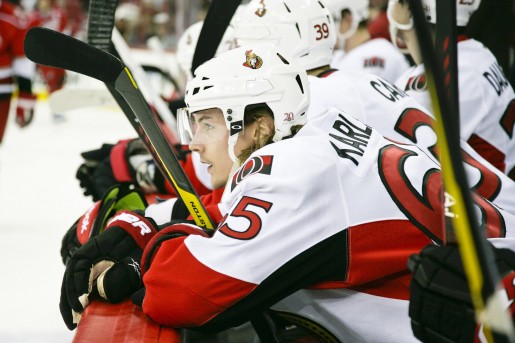For the last three years of Nicklas Lidstrom’s illustrious career, Detroit Red Wings’ fans heard that the next big thing was coming. They heard the praises being sung about the young Brendan Smith. Fans and scouts alike gushed about his speed, scoring prowess, and some of the more overzealous fans even compared him to a poor-man’s Bobby Orr. Flash forward to 2013-2014 and Red Wings’ fans have largely been disappointed with Smith’s play. Fans complain about his atrocious giveaways, his ill-timed offensive zone pinches, and his reckless 1-on-4 charges into the offensive zone when his team is changing lines. Fans are getting tired of it and the excuse that “he’s young” is starting to go by the wayside as Smith turned 25 in February. However, when you take a deeper look into Smith’s advanced stats, you see a player that has the potential to be a solid defenseman, with the possibility of being on Detroit’s top-pairing in just a few years. All stats are taken from Extra Skater.
| Player | 5-on-5 Close GF% | 5-on-5 Corsi F% | 5-on-5 Close Corsi F% | 5-on 5 Close Fenwick For% | 5-on-5 PDO | O/DSt% | TotTm% F QoC |
|---|---|---|---|---|---|---|---|
| Brendan Smith | 55.8% | 53.1% | 53.9% | 53.3% | 98.9 | 54.5% | 25.5% |
| Zdeno Chara | 62.3% | 54.9% | 56.4% | 56.5% | 101.8 | 47.9% | 27.4% |
| Niklas Kronwall | 52.1% | 51.1% | 50.5% | 50.4% | 101.1 | 51.4% | 27.1% |
| Duncan Keith | 59.2% | 56.6% | 57.7% | 56.3% | 100.9 | 57.2% | 25.7% |
| Shea Weber | 50.0% | 48.8% | 47.9% | 49.9% | 99.8 | 46.0% | 27.0% |
| Erik Karlsson | 49.4% | 54.6% | 53.9% | 52.7% | 99.8 | 54.6% | 26.1% |
| Ryan Suter | 49.2% | 48.3% | 47.8% | 48.0% | 100.1 | 54.1% | 26.6% |
Now hold your horses here. By no means am I trying to suggest that Smith is on the same level as some of the guys on this list. I’m merely showing that his possession numbers compare favorably with the elite defensemen of the NHL. It’s what you do with the puck that separates the great defensemen from the average and that’s where Smith has plenty of room to grow. However, what I wanted to point out was that Smith may have started to figure out what to do with the puck of late. Below is a similar chart to the one that I just showed you above, but instead of putting Smith’s full season numbers in there, I’ve put in his averages from the last 10 games and compared them to the season stats of the other defensemen.
| Player | 5-on-5 GF% | 5-on-5 CF% | O/DSt% | TotTm% QoC |
|---|---|---|---|---|
| Brendan Smith | 46.2% | 54.2% | 52.4% | 29.6% |
| Zdeno Chara | 60.5% | 54.9% | 47.9% | 29.9% |
| Niklas Kronwall | 50.5% | 51.1% | 51.4% | 29.7% |
| Duncan Keith | 56.3% | 56.6% | 57.2% | 28.8% |
| Shea Weber | 47.9% | 48.8% | 46.0% | 29.7% |
| Erik Karlsson | 47.5% | 54.6% | 54.6% | 29.1% |
| Ryan Suter | 55.0% | 48.3% | 54.1% | 29.3% |
From this chart, you can see that Smith’s 5-on-5 CF% is up more than a full percentage point and compares favorably with Erik Karlsson and Zdeno Chara. You can see that he’s being trusted to play against a high level of competition, similar to the other elite defensemen on this list. While this is an extremely small sample size, you can see that Smith may be on the verge of turning a corner. To me, Smith’s best comparison is one of the defensemen on this list – Ottawa Senators defenseman Erik Karlsson.

The Karlsson-Smith Comparison
Before Karlsson won the Norris Trophy in the 2011-2012 season, Karlsson was regarded in a similar manner that Smith is today. Karlsson was turnover prone, made too many offensive gambles, and was an atrocious -30 in the 2010-2011 season. However, something clicked for Karlsson in the 2011-2012 season. He made smarter outlet passes, made safer offensive plays, and ultimately he turned in one of the best offensive seasons for a defenseman in the last decade. I don’t believe that Smith has the same level of offensive talent as Karlsson, but Smith could benefit by watching Karlsson’s game tape. The other thing that could benefit Smith is to have coach Mike Babcock utilize him in a manner similar to how Senators’ coach Paul MacLean utilizes Karlsson.

Take a look back to the charts shown above and look at the O/DSt%. What this represents is the ratio of shifts that a player starts in the offensive zone versus the defensive zone at even strength. For Smith, in the last 10 games, he has started 52.4% of his shifts in the offensive zone. Karlsson starts about 54.6% of his shifts in the offensive zone which actually is the lowest total for him by a significant margin. In Karlsson’s Norris Trophy season, he started 56.4% of his shifts in the offensive zone and that number skyrocketed to 58.3% during last season. If Babcock can harness Smith’s offensive capabilities and trust him to make smarter plays in the offensive zone, he can make an effort to start more of Smith’s shifts in the offensive zone to maximize on his strong Corsi and Fenwick numbers.
Verdict on Smith
When you compare the advanced stats versus the eye test, you see a player that looks good on paper but still makes numerous mistakes. He tries to make the pretty pass, doesn’t dump the puck in enough, and still pinches at inopportune times. However, these mistakes are becoming less and less noticeable. I find myself no longer cursing at the television about a dumb play made by Brendan Smith and instead complimenting the easy, safe play he made. He’s got ways to go before he becomes anything close to an elite defenseman in the NHL like he was projected to be. But if Babcock can put Smith in positions to succeed like Paul MacLean does in Ottawa for Erik Karlsson, we might see Smith’s scoring numbers improve as well as seeing a reduction in mistakes simply because Smith is not stuck in positions where he is prone to make mistakes. I don’t think any of us ever expect Brendan Smith to be a dominant defenseman in the NHL. He’s not going to be a Nick Lidstrom-type player that can provide tons of offense AND shut down the other team’s best player. At best, I think his ceiling is a poor man’s Erik Karlsson – a guy that can chip in 40-50 points from the blue line and help start the rush with his great speed. The more he can reduce his mistakes, the more people will realize that Smith can be a decent player in the NHL and that not all hope is lost for him.